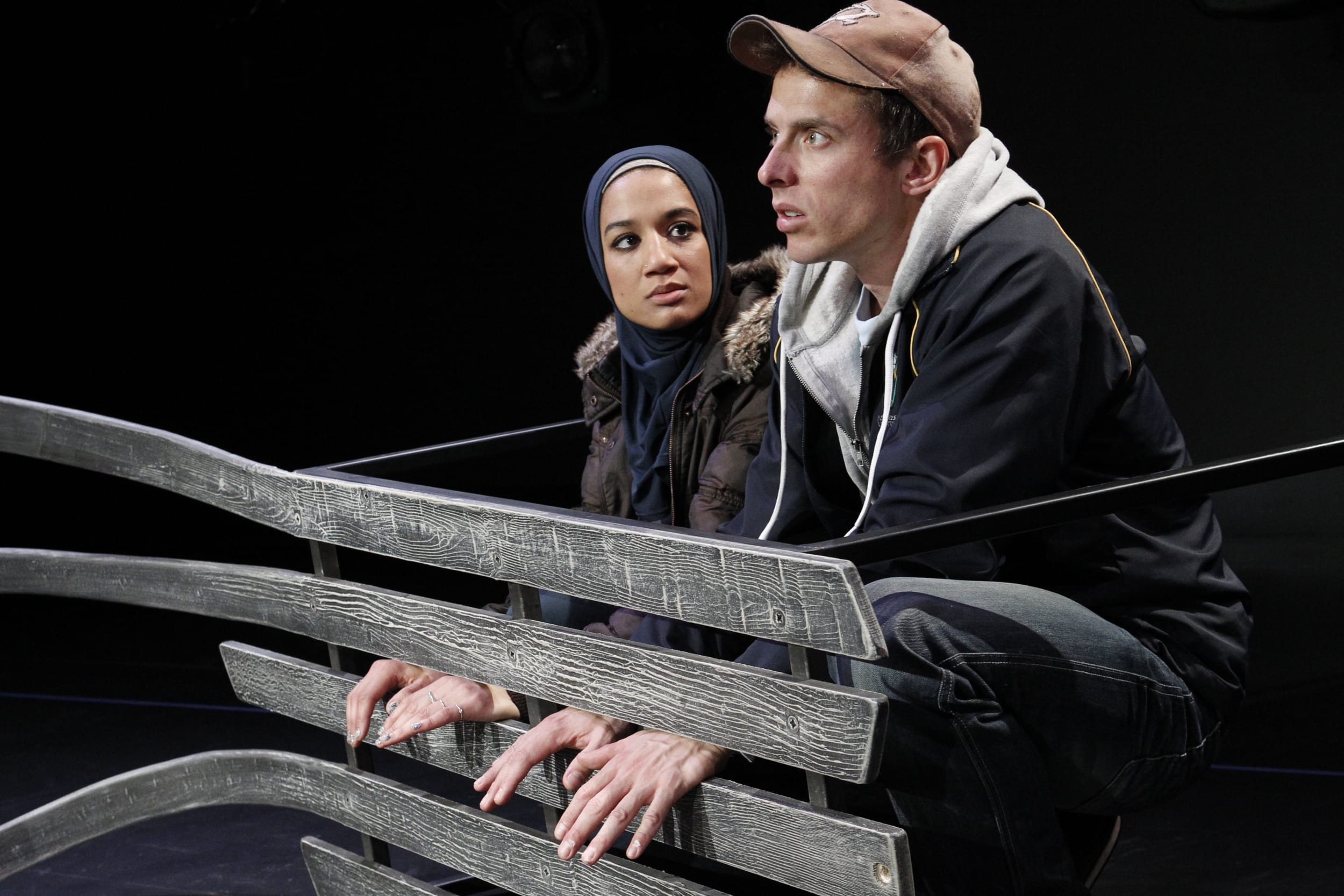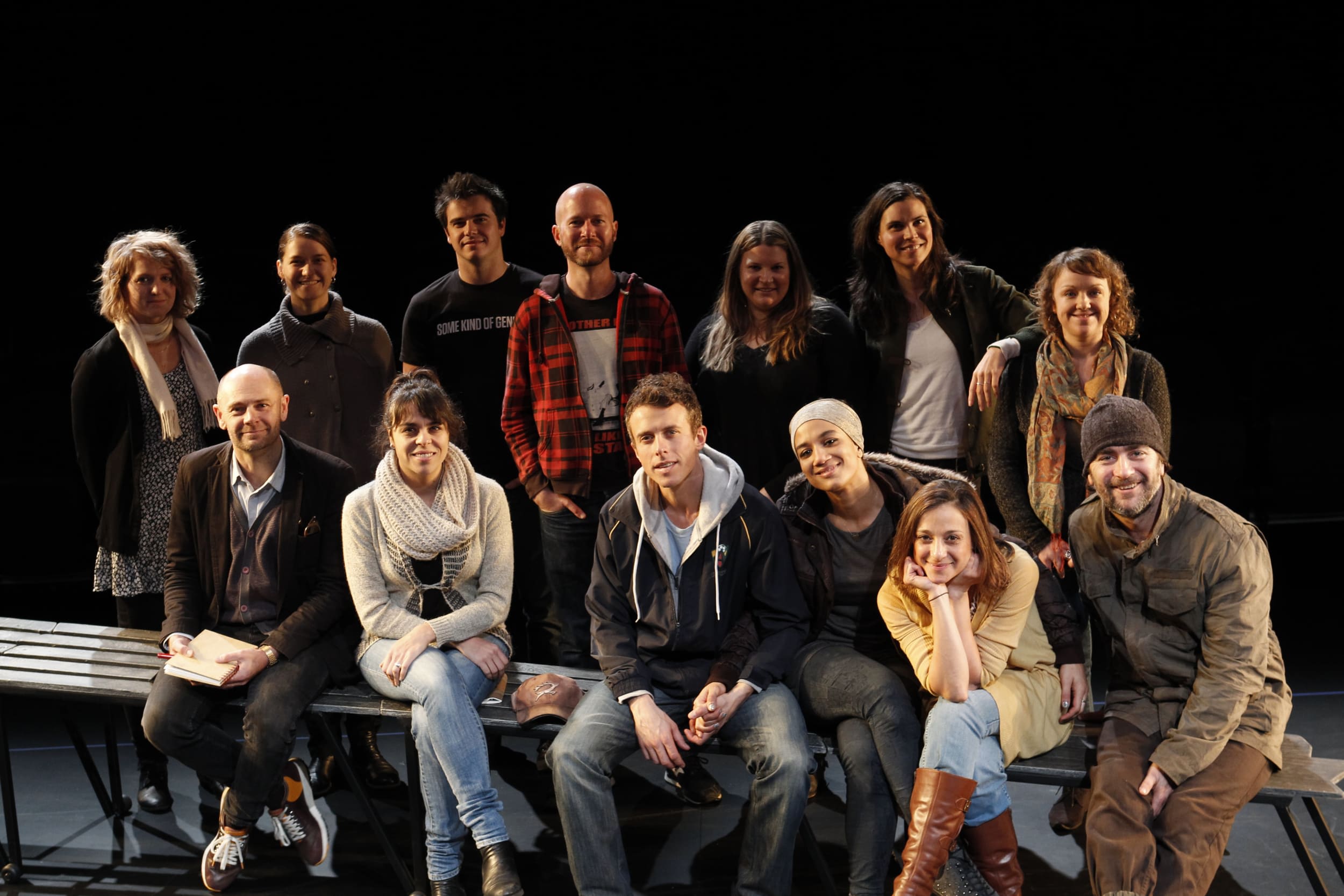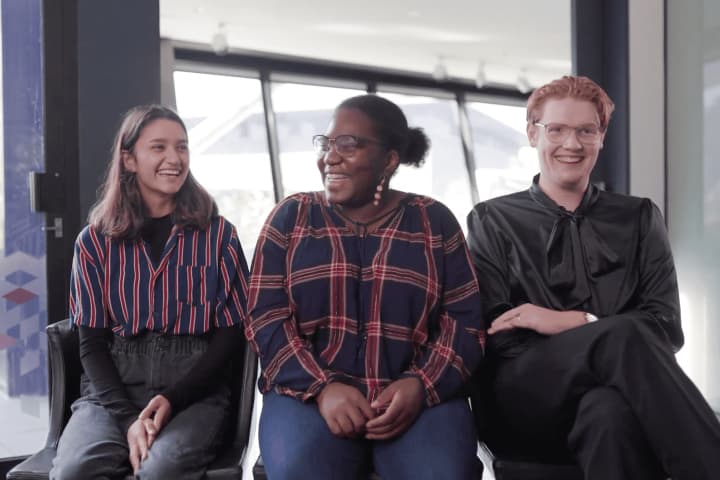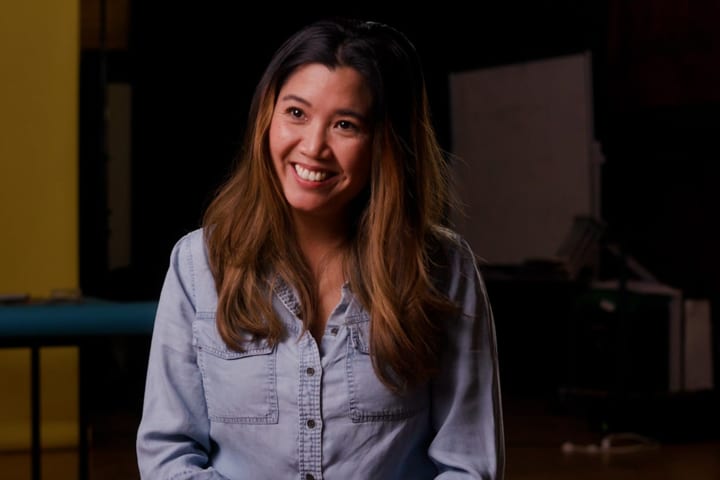Ahead of MTC's 2014 production of Yellow Moon by David Grieg, we sat down with the cast and director to learn more about the play.
When audiences come and see Yellow Moon what type of world are they invited to enter into?
Naomi Rukavina: I believe a very contemporary and current world, one that the youth of ‘right now’ from wherever can identify with. That’s the aim. I think Yellow Moon is a play that young people can look at and from whatever world they come from, and whatever challenges they face, they can feel that they aren’t alone.
Leticia Cáceres: It’s a very theatrical world. We were doing a run of the play just before and I noticed the scale of the space, the way the performers were interacting and their commitment to conjuring and imagining places and spaces and weather. They completely take us there with nothing. The magic of theatre!
Daniela Farinacci: It’s a hard world. It’s a world where things are tough and no one’s particularly privileged.
The play is originally set in Scotland. Has that original setting been maintained for this production? Where else could Yellow Moon be set?
Leticia Cáceres: It’s a problematic question. The play is set in Scotland and we haven’t changed any of the locations. Because we live here, in Australia, I don’t want to put any further barriers on the work. I want the audience to be connecting strongly to the characters and not be thinking, ‘Oh, can I follow this accent?’ The play hasn’t been written in Scottish vernacular so it’s not a problem if we don’t use accents. Like Naomi said, it’s set ‘now’ and its contemporary so it’s an imagined Scotland.
Daniela Farinacci: Of course we refer to place names that won’t be familiar but you could superimpose other suburbs or towns onto them. I think the play allows the audience to do that. It’s not so specific. We’ve changed a few small words to make the meaning clearer. For instance instead of saying ‘pants’ we say ‘undies’, just small references like that.
What are your thoughts about this play with regard to its style – is it a tragedy, is it a thriller, a drama, a love story – is it all of these?
Luke Ryan: I think Yellow Moon is a love story and in parts it is also a thriller. There are definitely tragic elements within it, but the ending is quite hopeful. If you think about Greek tragedy and how that is structured, in this play there is still the catharsis and the subsequent hope that comes from that for Lee and Leila. It is Lee and Leila’s story, and it is a love story for them. For Leila there is real cause for hope and for Lee there is possibility of hope and that life will change. I feel they may end up together.
Daniela Farinacci: And for Lee there is the hope that he won’t follow in the footsteps of his father and continue the cycle, rather that he will break that cycle. We don’t know though, possibly he won’t.
 Naomi Rukavina and Luke Ryan. PHOTO: Jeff Busby
Naomi Rukavina and Luke Ryan. PHOTO: Jeff Busby
Could we talk about language and how language works in this play? Daniela mentioned before that the language presents certain challenges.
Daniela Farinacci: The challenge is the narration. The bulk of what I speak in this play is narration, third person narration. It is very different to a more traditional dialogue piece so it is harder to learn. It is quite lyrical at times, poetical in its description. It is quite beautiful.
Leticia Cáceres: Obviously in this setting you are breaking down the fourth wall. So the relationship that the actor has with the audience is different. We are currently considering; when do we talk to the audience and when do we talk to each other? When are we commenting, when are we quoting? There are so many different layers with this material and that’s what makes it hard. It constantly shifts. Sometimes you are creating pictures and sometimes that takes a minute and sometimes that takes time.
Daniela Farinacci: When are the narrators ahead of the action, when are they behind it, when are they discovering it at exactly the same time. So it is really exciting. It turns ‘on a dime’.
Does Yellow Moon comment on, critique, present, or judge the contemporary world?
Luke Ryan: It doesn’t overtly critique but I feel there is a subtle commentary. Society has let Lee down. He isn’t living in a social vacuum, he is from a disadvantaged background, he lives on an estate, he doesn’t attend school, he seems to have no prospects and he makes certain choices as result of that.
Leticia Cáceres: Class is such a prominent thing in this play. You are constantly in that context and that’s what makes it a critique of society.
Luke Ryan: In the play Lee says to Leila that she want’s someone better than him. I think he finds it hard to believe in any other possibilities because that is what life is for everyone he knows and everyone he grows up with. There’s jail or a basic job. I don’t think the social critique is overt but Greig is showing us reasons for why things are as they are.
Mark Constable: I think the commentary is also about the futility of dreams. There’s a certain nihilistic view of the world. The boy dreams of his father, he creates a whole world around his father but his father is nothing like that. They all dream of something but none of it is true.
 The cast, crew and creative team of Yellow Moon. PHOTO: Jeff Busby
The cast, crew and creative team of Yellow Moon. PHOTO: Jeff Busby
One of the reasons that Yellow Moon has been selected for the VCE Playlists is because it is ‘non-naturalistic’. Students will be examining what is ‘non-naturalistic’ about the performance, the traverse configuration, how locations and places are created, how narration weaves in and out, and the impact of the stagecraft including acting.
Naomi Rukavina: It is very stagecraft rich, especially in a traverse playing space. While one side of the audience will miss something in one moment, they will gain something in another moment. The brain is beautiful as in what your imagination can construct. It does more than we can create short of being cinematic. In those tiny moments you miss your imagination goes into overdrive and fills in all the gaps. I think non-naturalistic theatre is the richest kind of theatre. Like when you read a book and you create the entire universe in your head. With this show we give a framework and then ask everyone’s imagination to take over. I love working in this type of theatre. We have four prop/set items. The rest we create with our bodies, our words and the space.
Mark Constable: Working in traverse places a strong physical demand on you as a performer. If you are facing one way, that audience is hearing it and the other side is seeing it physically from behind. It imposes upon the performer the need to find clarity in the words and in the physical rendering of the moment. Rather than a completely naturalistic approach where you can be a mere talking head, in this production in any moment you are constantly thinking; what is the physical shape I am creating so that everyone around me is seeing that shape? When you aren’t in the scene that is taking place what are you doing? I’ve been thinking a lot about what I am doing while I am just standing in the corner. Am I facing diagonally, am I looking straight ahead or down? What is the audience reading from that actor doing that in that moment? All forms of theatre demand those choices, but traverse theatre particularly.
Daniela Farinacci: There is also a sense that we need to keep moving. We traverse many landscapes and the time shifts really quickly so the configuration really assists that. You can’t stay stationary for too long unless you are literally not in that scene which doesn’t happen very often.
And you never leave the space do you? You don’t go ‘off stage’?
Daniela Farinacci: We never leave the space. What I was referring to before about the language and the detail in the language, the actors can remain very still doing very little in the space but this allows the words to come to the fore. The description of moments can be enough. Miming isn’t really necessary. We tried doing lots of miming in week one and we got rid of that very quickly.
Leticia Cáceres: Stylistically, it looks like we are doing a kind of short hand all the time. We keep asking; what’s the quickest way we can find that will get us into that moment? There’s a lot of description in certain scenes. For instance when Leila gets a magazines and some razors and she goes into the toilet and then…we can’t mime all of that and nor do we want to. We have to find one or two iconic moments and movements that capture it and the rest the audience can listen to and fill in the gaps. That is quite satisfying stylistically. There is a simplicity and fluidity to it that hopefully won’t allow it to get bogged down.
Luke Ryan: It’s highly theatrical as a play but it’s also highly filmic. It shifts scenes and locations rapidly. You are constantly moving with the characters. The description and narration drives it; from the superstore, the toilet, the cemetery, back to the superstore, back at the estate, at the train station. I don’t know if it is deliberate or not but I feel that there is a lot of filmic concepts being used and referenced; Bonnie and Clyde, Days of Heaven, Badlands, and even Thelma and Louise. I was also thinking about Trainspotting those moments where the texts says, ‘Meet Billy Logan’, very much in that style although I’m not sure whether David Greig has been deliberate here. The audience will experience four actors with four objects in a space but ideally in their imaginations they are going to be seeing a film streaming. Getting the clarity in the images that the texts suggest is important.
Daniela Farinacci: We haven’t added in the sound yet and I believe that is going to be significant and will provide a very rich layer.
How is the set design, those four benches contributing to the direction and style of the work?
Daniela Farinacci: They contribute every step of the way, and it’s really helpful. Again sometimes the set pieces just gesture to the meaning or the moment or the place. It really helps us as performers, so we don’t feel alone in an empty space
Leticia Cáceres: They can symbolise things so powerfully. If you turn them upside down they suddenly become dead animals. At other times they are tree branches or a train carriage. The design has been really helpful in allowing this.
Daniela Farinacci: We ask this of the audience right from the top of the show. We shift something, then the four performers endow it with words and action or interaction and the audience pick up on that pretty quickly. That’s the style of the show; now it’s this…okay…and now it’s that.
Mark Constable: The design is also a practical decision on behalf of the designer, Melanie Liertz. Yellow Moon is touring so it needs to be created in such a way that will allow it to be performed in a number of different spaces. With a text such as this you don’t want to over burden it with things that will just get in the way. We want the audience to be free to use their imagination. We suggest this and that and the audience is willing to say: yes I believe you are on a train, yes I believe you are in the highlands, yes I believe you in the snow. If you over complicate it you lose that. A simple beanie can completely change you. If your coat gets done up you are a different character.
Leticia Cáceres: There is a broader political point to be made here. There is a perception for some people that things just can’t change, that people can’t change. When you watch actors changing in front of you, that can be a powerful political message for young audiences. There is the possibility for things to change and that leads to hope.
This is an excerpt from the extended interview conducted by Meg Upton as part of the Yellow Moon Teachers' Notes.
Published on 9 May 2014





